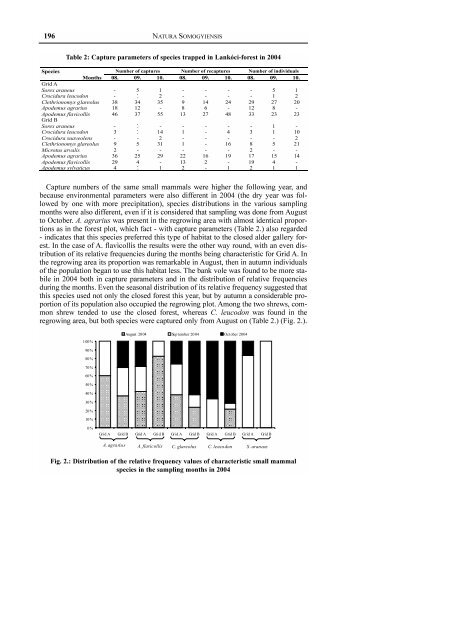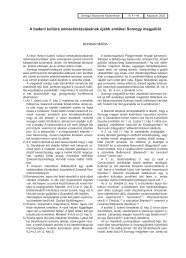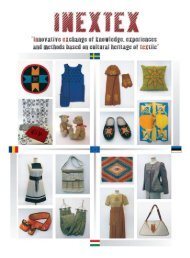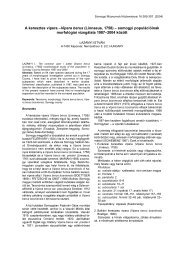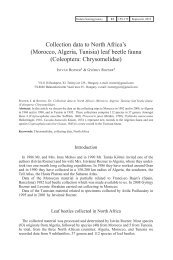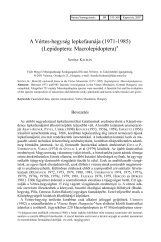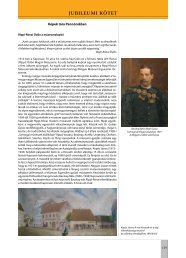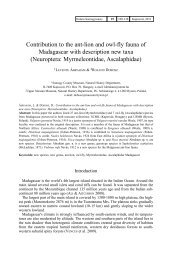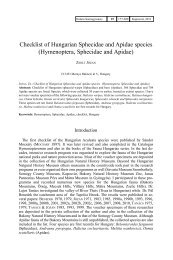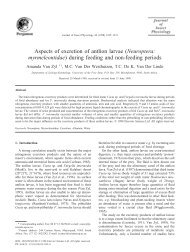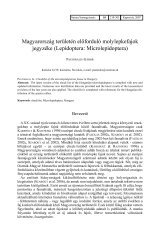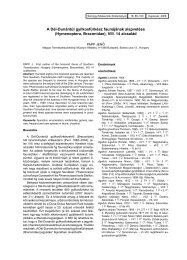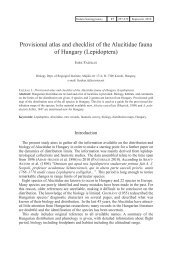Population dynamics and spatial pattern of small mammals in ...
Population dynamics and spatial pattern of small mammals in ...
Population dynamics and spatial pattern of small mammals in ...
Create successful ePaper yourself
Turn your PDF publications into a flip-book with our unique Google optimized e-Paper software.
196<br />
NATURA SOMOGYIENSIS<br />
Table 2: Capture parameters <strong>of</strong> species trapped <strong>in</strong> Lankóci-forest <strong>in</strong> 2004<br />
Capture numbers <strong>of</strong> the same <strong>small</strong> <strong>mammals</strong> were higher the follow<strong>in</strong>g year, <strong>and</strong><br />
because environmental parameters were also different <strong>in</strong> 2004 (the dry year was followed<br />
by one with more precipitation), species distributions <strong>in</strong> the various sampl<strong>in</strong>g<br />
months were also different, even if it is considered that sampl<strong>in</strong>g was done from August<br />
to October. A. agrarius was present <strong>in</strong> the regrow<strong>in</strong>g area with almost identical proportions<br />
as <strong>in</strong> the forest plot, which fact - with capture parameters (Table 2.) also regarded<br />
- <strong>in</strong>dicates that this species preferred this type <strong>of</strong> habitat to the closed alder gallery forest.<br />
In the case <strong>of</strong> A. flavicollis the results were the other way round, with an even distribution<br />
<strong>of</strong> its relative frequencies dur<strong>in</strong>g the months be<strong>in</strong>g characteristic for Grid A. In<br />
the regrow<strong>in</strong>g area its proportion was remarkable <strong>in</strong> August, then <strong>in</strong> autumn <strong>in</strong>dividuals<br />
<strong>of</strong> the population began to use this habitat less. The bank vole was found to be more stabile<br />
<strong>in</strong> 2004 both <strong>in</strong> capture parameters <strong>and</strong> <strong>in</strong> the distribution <strong>of</strong> relative frequencies<br />
dur<strong>in</strong>g the months. Even the seasonal distribution <strong>of</strong> its relative frequency suggested that<br />
this species used not only the closed forest this year, but by autumn a considerable proportion<br />
<strong>of</strong> its population also occupied the regrow<strong>in</strong>g plot. Among the two shrews, common<br />
shrew tended to use the closed forest, whereas C. leucodon was found <strong>in</strong> the<br />
regrow<strong>in</strong>g area, but both species were captured only from August on (Table 2.) (Fig. 2.).<br />
Fig. 2.: Distribution <strong>of</strong> the relative frequency values <strong>of</strong> characteristic <strong>small</strong> mammal<br />
species <strong>in</strong> the sampl<strong>in</strong>g months <strong>in</strong> 2004


